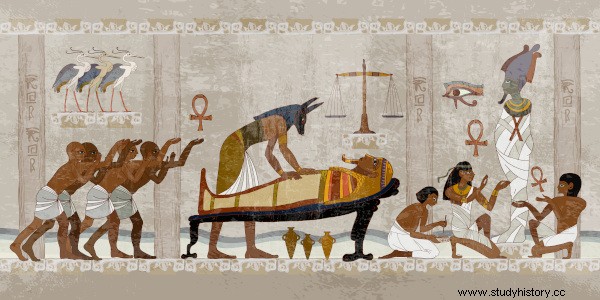
Anubis he was the god of the dead and mummification for the ancient Egyptians. This deity had a strong relationship with death and the afterlife. Over time, he lost the position of god of the dead to Osiris, and many of his attributes and epithets were transferred to this other Egyptian god.
The Egyptians represented Anubis in the form of a jackal and he was believed to be the protector of tombs and the patron of the embalming ritual. He had important roles in the afterlife, being the protector of the dead in this other dimension. Anubis also served a function in the court of Osiris, the place where the dead were judged according to Egyptian cosmology.
Learn more: Great Pyramid of Giza — huge sarcophagus commissioned by a pharaoh
Anubis Summary
-
Anubis was the god of the dead and mummification for ancient Egyptians.
-
The cult of Anubis is believed to have formed during the Pre-Dynastic period.
-
Over the years, Anubis lost his status as god of the dead to Osiris.
-
He was represented with a human body and a jackal's head.
-
He had an important cult, spread over cities like Memphis and Saka.
Anubis, god of the dead
Anubis was a traditional deity that was part of the religiosity practiced by the Egyptians in Ancient Age . Initially, Anubis was recognized by the Egyptians as the god of the dead, but he gradually lost this position to Osiris, as we will see. The Egyptians also considered him the god of mummification, relating him directly to the afterlife and the act of embalming the dead.
He was represented by the Egyptians in the form of a jackal or more commonly with a human body but with the head of a jackal. The head of Anubis was represented in black, a tone that symbolized the decomposition of the body on Earth and its rebirth in another dimension. The black color for the Egyptians was directly related to the fertile soil of the Nile River.
It is assumed that Anubis was represented as a jackal end of securing tomb protection Egyptians, who were targeted by dogs during the Pre-Dynastic period. With this, it is believed that the cult of Anubis was established sometime in this period, which extended from 6000 BC. to 3150 BC
The Egyptians called Anubis Anpu , Anubis being the way the Greeks recorded the name of this god. In addition, Anubis had a number of epithets that highlighted certain qualities he possessed. One of these epithets was “The First of the Westerners”, used to refer to the importance that Anubis had in the afterlife (the Egyptians called those who were in the afterlife Westerners).
Other epithets that reinforced Anubis' connection with the afterlife were "Lord of the holy land" and "Dog that devours millions". As mentioned, Anubis was considered the god of the dead, but he progressively lost that position to Osiris, and this happened around the Middle Kingdom, which extended from 2040 BC. to 1782 BC
As this shift took place in Egyptian religiosity, Anubis lost epithets and came to be seen primarily as a protective god of the dead in the afterlife and a patron of the act of death. embalming (part of the funerary rites of the Egyptians).
Finally, the Egyptians considered Anubis the god responsible for protecting the tombs of the dead and preventing them from being violated by animals or thieves. Anubis had a daughter named Kebechet, who was the result of his relationship with Anput, goddess of funerals. Anubis' daughter brought ice water to the dead in the afterlife.
Anubis in Egyptian mythology
Initially, Anubis was considered the son of Ra and Hesat, but the origins of this god were changed, and Anubis comes to be seen as the son of Osiris and Nephthys . Nephthys would have disguised herself as Isis, wife of Osiris, and had sexual relations with him. From this relationship Anubis was born, but Nephthys abandoned him.
This is because Nephthys feared that her husband would be jealous of the fact that she had become pregnant with Osiris. Nephthys and Osiris' involvement fueled the hatred of Set, Nephthys' husband, who murdered Osiris and threw his body into the Nile River. Anubis was raised by Isis as if he were her own child.
Also, Egyptian myths mentioned Anubis' participation in the Court of Osiris , the court in which the actions of the dead were judged. This court was responsible for determining who would be elevated to paradise or condemned to have their soul destroyed. In that court, Anubis conducted the process in which the dead person's heart (symbolizing his actions) was weighed against a feather (symbol of justice). A heart lighter than the feather represented the person's salvation, and a heavier heart represented the damnation of his soul.
Also read: Tutankhamun's Curse — Mysterious Egyptian Inscription Found in a Tomb
Anubis in Egyptian piety
Anubis was an important god in Egyptian religiosity. His cult of him spread through different regions of Ancient Egypt , although it was most significant in Upper Egypt. Two places that centralized the cult of Anubis were the cities of Cinópolis and Saka. However, many shrines were built throughout Egypt.
The god Anubis was considered the patron of Memphis, because of his relationship with death and embalming. The priests who worshiped Anubis used to wear jackal-shaped masks. During rituals, it was common for representations of this god to be performed.
The popularity of Anubis in Egyptian religiosity, despite its little importance in myths, is explained by its association with death and the afterlife , very important elements in the cosmology of the ancient Egyptians.
